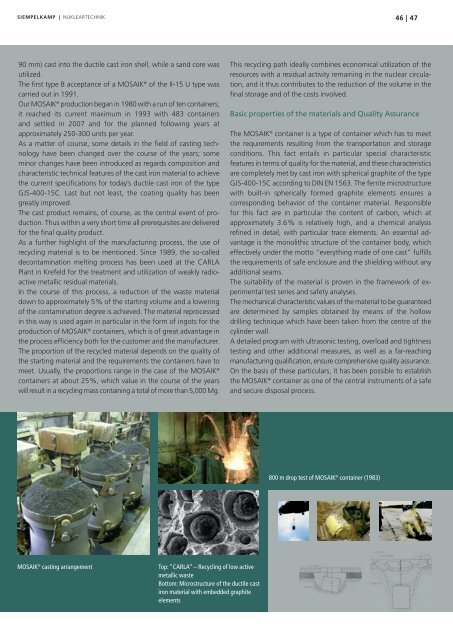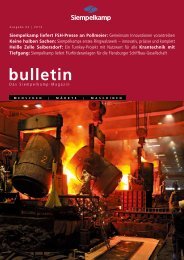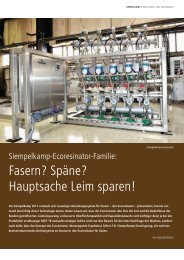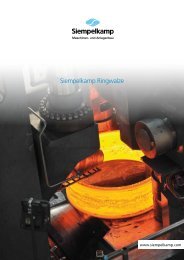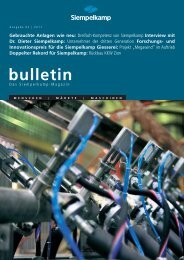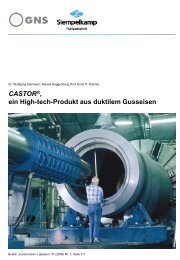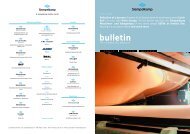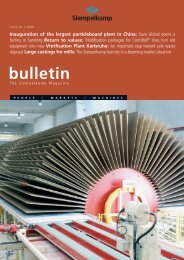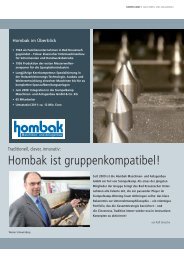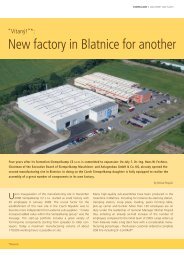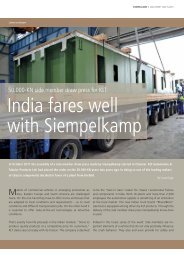Bulletin 1/2008 - Siempelkamp
Bulletin 1/2008 - Siempelkamp
Bulletin 1/2008 - Siempelkamp
Create successful ePaper yourself
Turn your PDF publications into a flip-book with our unique Google optimized e-Paper software.
SIEMPELKAMP | NUKLEARTECHNIK 46 | 47<br />
90 mm) cast into the ductile cast iron shell, while a sand core was<br />
utilized.<br />
The first type B acceptance of a MOSAIK ® of the II-15 U type was<br />
carried out in 1991.<br />
Our MOSAIK ® production began in 1980 with a run of ten containers;<br />
it reached its current maximum in 1993 with 483 containers<br />
and settled in 2007 and for the planned following years at<br />
approximately 250-300 units per year.<br />
As a matter of course, some details in the field of casting technology<br />
have been changed over the course of the years; some<br />
minor changes have been introduced as regards composition and<br />
characteristic technical features of the cast iron material to achieve<br />
the current specifications for today’s ductile cast iron of the type<br />
GJS-400-15C. Last but not least, the coating quality has been<br />
greatly improved.<br />
The cast product remains, of course, as the central event of production.<br />
Thus within a very short time all prerequisites are delivered<br />
for the final quality product.<br />
As a further highlight of the manufacturing process, the use of<br />
recycling material is to be mentioned. Since 1989, the so-called<br />
decontamination melting process has been used at the CARLA<br />
Plant in Krefeld for the treatment and utilization of weakly radioactive<br />
metallic residual materials.<br />
In the course of this process, a reduction of the waste material<br />
down to approximately 5% of the starting volume and a lowering<br />
of the contamination degree is achieved. The material reprocessed<br />
in this way is used again in particular in the form of ingots for the<br />
production of MOSAIK ® containers, which is of great advantage in<br />
the process efficiency both for the customer and the manufacturer.<br />
The proportion of the recycled material depends on the quality of<br />
the starting material and the requirements the containers have to<br />
meet. Usually, the proportions range in the case of the MOSAIK ®<br />
containers at about 25%, which value in the course of the years<br />
will result in a recycling mass containing a total of more than 5,000 Mg.<br />
MOSAIK ® casting arrangement Top: “CARLA” – Recycling of low active<br />
metallic waste<br />
Bottom: Microstructure of the ductile cast<br />
iron material with embedded graphite<br />
elements<br />
This recycling path ideally combines economical utilization of the<br />
resources with a residual activity remaining in the nuclear circulation,<br />
and it thus contributes to the reduction of the volume in the<br />
final storage and of the costs involved.<br />
Basic properties of the materials and Quality Assurance<br />
The MOSAIK ® container is a type of container which has to meet<br />
the requirements resulting from the transportation and storage<br />
conditions. This fact entails in particular special characteristic<br />
features in terms of quality for the material, and these characteristics<br />
are completely met by cast iron with spherical graphite of the type<br />
GJS-400-15C according to DIN EN 1563. The ferrite microstructure<br />
with built-in spherically formed graphite elements ensures a<br />
corresponding behavior of the container material. Responsible<br />
for this fact are in particular the content of carbon, which at<br />
approximately 3.6% is relatively high, and a chemical analysis<br />
refined in detail, with particular trace elements. An essential advantage<br />
is the monolithic structure of the container body, which<br />
effectively under the motto “everything made of one cast” fulfills<br />
the requirements of safe enclosure and the shielding without any<br />
additional seams.<br />
The suitability of the material is proven in the framework of experimental<br />
test series and safety analyses.<br />
The mechanical characteristic values of the material to be guaranteed<br />
are determined by samples obtained by means of the hollow<br />
drilling technique which have been taken from the centre of the<br />
cylinder wall.<br />
A detailed program with ultrasonic testing, overload and tightness<br />
testing and other additional measures, as well as a far-reaching<br />
manufacturing qualification, ensure comprehensive quality assurance.<br />
On the basis of these particulars, it has been possible to establish<br />
the MOSAIK ® container as one of the central instruments of a safe<br />
and secure disposal process.<br />
800 m drop test of MOSAIK ® container (1983)


